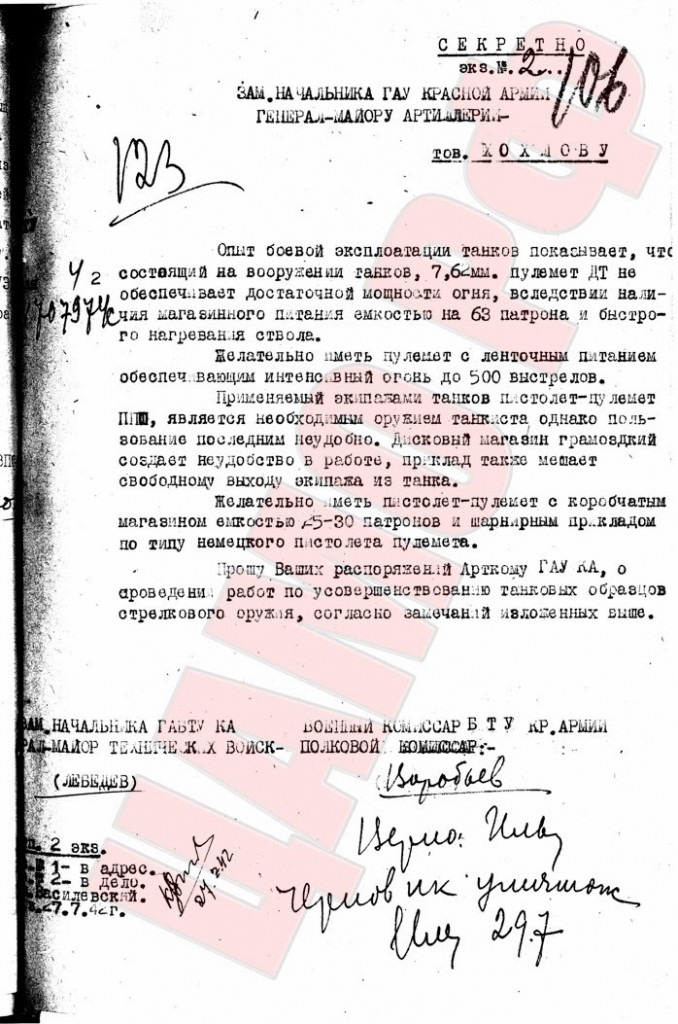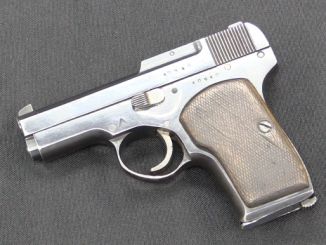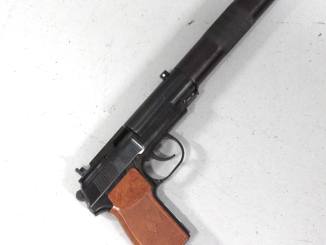Today, I’m swiping another document from the cool-but-stagnant Soviet Gun Archives. This time, it’s a memo requesting the development of what would become the PPS-43:
 As I haven’t had time to learn Russian yet, I will defer to Soviet Gun Archives for the translation:
As I haven’t had time to learn Russian yet, I will defer to Soviet Gun Archives for the translation:
To the deputy commander of the Red Army GAU, Major-General of Artillery, comrade HohlovExperience shows that the 7.62 mm DT tank machinegun does not provide sufficient volume of fire, due to its 63 round magazine and rapid heating of the barrel. It is desirable to have a belt-fed machinegun, capable of rapidly firing up to 500 rounds.The PPSh submachinegun is a necessary weapon for tank crews, but is inconvenient to use. The disk magazine is large, and gets in the way. The stock impedes exiting the tank. It is desirable to have a submachinegun with a box magazine that holds 25-30 rounds and a folding stock, like the one on the German SMG.I ask you to instruct Artkom to begin work on improving firearms for tank crews according to the issues noted above.Deputy GABTU Chief, Major-General of Technical Forces, LebedevBTU Military Commissar, Regimental Commissar Vorobyev




EXCELLENT, thnx, Ian…
Wasn’t the PPSh a Soviet copy of the Finnish Suomi?
Not at all, but they can look like it until you get close.
Drum magazine of Suomi was copied, the PPSh was made using metal stamping method to reduce time needed to production
The earlier PPD-40 SMG was closely based on the Suomi. As such, it was mostly machined parts, and thus was both fairly expensive and time-consuming to manufacture.
The PPSh-41 was developed as a low-cost, stamped successor to PPD-40 more suited to high-speed mass-production. PPD-40s did, however, remain in service with the Red Army right through the war and even into the postwar era. Simply put, they needed every gun they had, and then some.
cheers
eon
the only thing PPD-40 has that is based on Suomi is its drum. The PPD itself was first adopted in 1934 as PPD-34, and like most subguns of the time, it was inspired by Schmeisser MP.18 and MP.28, rather than Suomi
PPSh trigger mechanism is very simillar to the Suomi
Only the drum magazine was copied on the soviet side, not the mechanics as such. However, in Finland when Suomi was found as a really expensive gun to manufacture the PPS was copied and manufactured as m/44, in 9mm and using Suomi SMG mags (both stick and drum). Some 20,000 were ordered but just around 10,000 eventually manufactured before the war ended. In recent years they deactivated lots of the old guns and sold them to civilians, with rest I presume ending up as scrap metal. I wonder how many of them survived in actual working condition :\
Thanks.
“we should note that the requested belt-fed replacement for the DT was also put into service in 1943, in the form of the Goryunov SG-43”
In fact before the war the DS-39 machine gun was ordered to be implemented in new tanks design but DS-39 proved itself not reliable enough
“it’s a memo requesting the development of what would become the PPS-43”
It is impossible. This document is dated 27.7.1942 when the first field trials of PPS was done 6 – 13 June 1942 in to Leningrad Front [1], so this memo can’t cause development of PPS.
[1]Source: http://ru.wikipedia.org/wiki/Пистолет-пулемёт_Судаева
I should say: that this memo don’t cause the creation of PPS, not the development of PPS. Sorry, my fault.
I think the comment about speed of development is interesting when you consider the usual glacial speed of US ordnance. The need for an effective GPMG comparable to the MG34 and MG42 was recognized quite early, yet the best they could do before the war ended was the M1919A6. And with all the experimental M1 Garands Ordnance produced, none of them entered service before the war ended (though the T20 would have if Japan hadn’t surrendered).
According to E.C. Ezell in the 11th edition of Small Arms of the World, the major stumbling-block was the .30-06 cartridge (7.62 x 63mm), which wasn’t ideal for high-rate-of-fire weapons with relatively lightweight bolts (such as adapted M1 Garand type rifles) due to its OAL and profile. The result, of course, was the T65E3 cartridge, aka 7.62 x 51mm, optimized for full-automatic actions. It was developed in the 1947-49 timeframe, and eventually “married up” with the T-44E4 rifle, which became the M-14.
cheers
eon
Some points there:
1) development of the new, folding stock subgun with box magazine and reduced ROF of 500 rpm or so was initiated well before this note – first such prototypes were officially tested in February, 1942.
2) SG-43 was put into limited service in 1944, as an infantry gun. Tank version appeared only post-war, as SGMT
“development of the new, folding stock subgun with box magazine and reduced ROF of 500 rpm or so was initiated well before this note”
And also Korovin SMG of 1941 shouldn’t be forget. It was effect of desperate need of gun produced in Tula in 1941 but I wonder that it influent the later development of Soviet sub-machine guns?
a bit of OT: Ian, have you got my email on R-4 .22lr pistol for FW?
An interesting document that helps fill out a little more of the recorded history of PPS-43 development. The comments from Daweo and Max Popenker are also quite informative and much appreciated. As an owner of a Radom-manufactured PPS-43C ( semi-automatic U.S. market version with the folding stock locked permanently in the folded position due to BATF rules — unfortunately — but the gun is still pretty accurate in spite of this and an absolute blast to shoot ), I found the added insights most helpful. A big “Thank You” to one and all for this article!